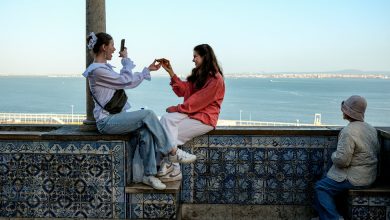Venice Biennale: Attacking Mexico, With Mexico’s Approval

MEXICO CITY — If one work were to sum up Mexico’s exhibition at the 2022 Venice Biennale, it would be Naomi Rincón Gallardo’s dark allegory “Vermin Sonnet.” The 20-minute video features a bat, a snake, a scorpion and a choir of frogs desperately making their way in a futuristic world ravaged by environmental ruin and social disorder.
Rejected and isolated, these outcasts manage to communicate via radio signals and establish their own alternative community — until a crocodile eats them all.
In an interview, Ms. Rincón Gallardo described her project as a “manifesto for unwanted species” and said she hoped viewers in Italy would catch on to its “queer, transgressive, subversive messages.”
With works like “Vermin Sonnet” setting the tone, the Mexico pavilion is likely to be colorful this year, though not exactly cheerful. Four artists will present objects that, in one way or another, explore how the Spanish conquest of Latin America disrupted the region and established repressive social systems that continue to affect the country. Rampant violence, racial discrimination and exploitation of land and people in the name of progress — these are not the themes that Mexico’s tourism bureau might have included in a display meant to represent the nation.
But Mexico’s cultural agencies are different. Like many countries across the Americas, Mexico is in the midst of an extended reckoning over how the civil and religious structures established during the colonial period contribute to present-day inequality — and, too often, danger for women, minorities, Indigenous communities and those who dissent from the political order.
The country’s leading cultural authority, the National Institute of Fine Arts and Literature, aims to take a primary role — formally and officially — in fostering these difficult discussions and letting the world know that Mexico is staring down its internal demons.
“In Mexico, in this period of government, we are facing those challenges as public policy,” said Lucina Jiménez, the general director of the institute, which oversees 18 museums and coordinates the Venice exhibition.
This government-sanctioned agitation has led to its own disruptions, and even violence, most notably in December 2019, when an angry mob descended upon the Palacio de Bellas Artes museum here to protest the exhibition of a painting that feminized an iconic image of Emiliano Zapata on horseback, presenting that early-20th-century revolutionary hero naked except for a pink sombrero and high heels shaped like pistols. The crowd was eventually calmed, but some were injured in the melee.
Ms. Jiménez, whose office is one floor above the museum’s exhibition space, quickly took to Twitter to explain the government’s support for the controversial work, by the artist Fabián Cháirez, and the show that featured it: “In the defense of freedom of creation and expression, in the exercise of the right to diversity, our democracy is resolved,” she wrote in Spanish.
That background is crucial to understanding how the institute came to embrace the curators Catalina Lozano and Mauricio Marcin’s biennale proposal. As Ms. Lozano described it in an interview, they sought to bring together artists whose work “explores other ways of doing, being, thinking” that contrast with common perceptions of how the country sees itself, what language it speaks and how its government and businesses operate.
There are two Mexicos, she said: “the Mexico that has embraced modernity and the Mexico that resists the colonial impulse of modernity.”
The exhibition, “Until the Songs Spring,” aims to promote a “rich diversity and heterogeneity over one single way of seeing Mexico,” Mr. Marcin said. In other words, it presents not just a Spanish-speaking country with 400 years of post-conquest history, but also a collection of geographies that dates back more than 20 centuries and where 68 languages are spoken, each communicating a distinct way of seeing the world.
In that way, “Until the Songs Spring” — the title borrows from a poem written by the Indigenous ruler Temilotzin, who died in 1525 — bridges different periods.
Mariana Castillo Deball’s “Calendar Fall Away,” for example, covers the entire floor of the 2,700-square-foot exhibition area with symbols evoking official documents generated by both the early Spanish colonialists and the pre-Columbian civilizations that were already inhabiting the space that is now called Mexico. The mash-up confirms conflicting ways of governing and timekeeping, even though the European one emerged as dominant. Ms. Castillo Deball is also making prints from sections of the work, which doubles as a template, to display in Venice.
Santiago Borja’s “Talel” is a response to present-day textile commerce, which, he asserts, employs the ancient craft of weaving but overlooks the human presence in the manufacturing process. Consisting of 23 large wool panels woven on traditional backstrap looms by female workers in Chiapas, it is designed to interpret the way science represents the human genome. The weavers were encouraged to create their own methods of stitching and patterning and to incorporate small, personal objects into their final work.
“The idea was to make every piece completely different because it was made by a different woman, but it is a very subtle thing,” the artist said.
The fourth artist, Fernando Palma Rodríguez, who is trained as an engineer and known for making low-tech robotic objects, is contributing “Tetzahuitl,” a motion-activated work that incorporates 43 children’s dresses that hang from a wooden structure. The word “tetzahuitl,” which comes from the Indigenous Náhuatl language, refers to deities whose appearances serve as harbingers of events.
The piece is intended to raise awareness of violence against women and minorities, though its meaning is broader than that. The number 43 resonates deeply in Mexico, resurrecting memories of the 43 “desaparecidos,” the male students at a teachers college in the state of Guerrero who were kidnapped and “disappeared” in 2014, setting off years of protests against official corruption and organized crime.
The contradiction of “Until the Songs Spring” is that it contains anti-establishment messages even though it is organized and financed by the federal government, the largest of all Mexican establishments. That is not lost on the curators or the team led by Ms. Jiménez, who said they were resolved to support challenging art, while still seeming a little battle-weary over the Palacio de Bellas Artes incident. Several people involved in the exhibition’s creation expressed concern over how it would be received in its home country. They are likely to find out when the show finishes in Venice and then begins a national tour, starting in liberal-minded Mexico City, then heading to more conservative places like Monterrey and Guadalajara.
The artists involved are feeling a separate unease. All four have built reputations as subverters and government critics and yet, here they are, representing under the green, white and red banner of Mexico, a fact that Mr. Borja described as “troublesome.” It may also, however, be an extraordinary opportunity to rewrite the country’s story on the artists’ own terms.
“I think it’s always important to make cracks in every system,” Ms. Rincón Gallardo said, “and I’m trying to provide a crack in that narrative at the national pavilion.”





